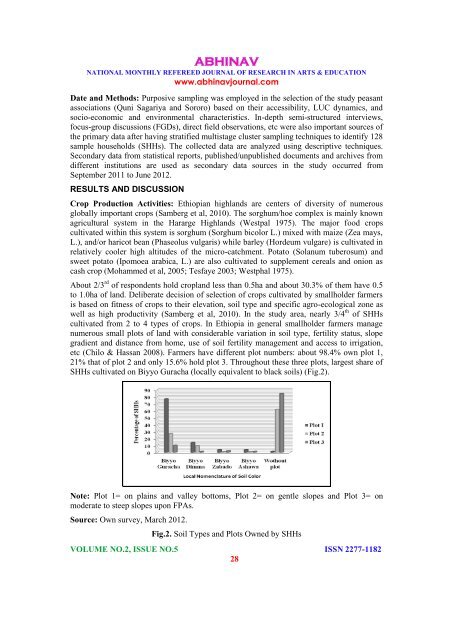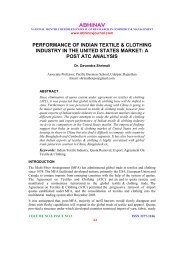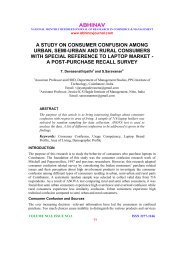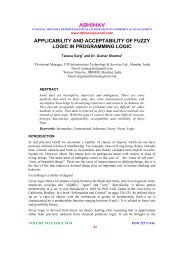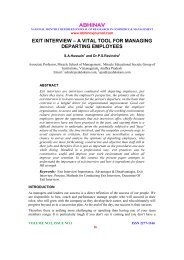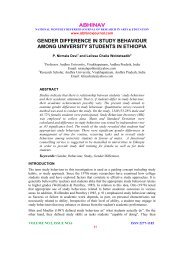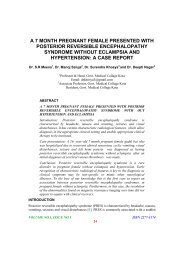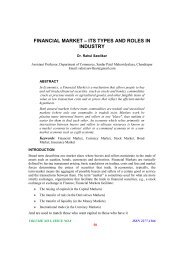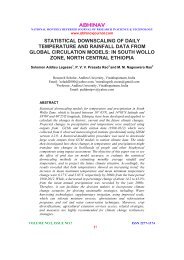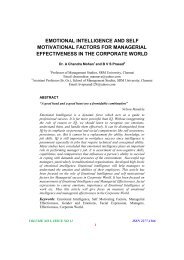Livelihood Activities, Challenges and Strategies at Participatory ...
Livelihood Activities, Challenges and Strategies at Participatory ...
Livelihood Activities, Challenges and Strategies at Participatory ...
Create successful ePaper yourself
Turn your PDF publications into a flip-book with our unique Google optimized e-Paper software.
ABHINAV<br />
NATIONAL MONTHLY REFEREED JOURNAL OF RESEARCH IN ARTS & EDUCATION<br />
www.abhinavjournal.com<br />
D<strong>at</strong>e <strong>and</strong> Methods: Purposive sampling was employed in the selection of the study peasant<br />
associ<strong>at</strong>ions (Quni Sagariya <strong>and</strong> Sororo) based on their accessibility, LUC dynamics, <strong>and</strong><br />
socio-economic <strong>and</strong> environmental characteristics. In-depth semi-structured interviews,<br />
focus-group discussions (FGDs), direct field observ<strong>at</strong>ions, etc were also important sources of<br />
the primary d<strong>at</strong>a after having str<strong>at</strong>ified multistage cluster sampling techniques to identify 128<br />
sample households (SHHs). The collected d<strong>at</strong>a are analyzed using descriptive techniques.<br />
Secondary d<strong>at</strong>a from st<strong>at</strong>istical reports, published/unpublished documents <strong>and</strong> archives from<br />
different institutions are used as secondary d<strong>at</strong>a sources in the study occurred from<br />
September 2011 to June 2012.<br />
RESULTS AND DISCUSSION<br />
Crop Production <strong>Activities</strong>: Ethiopian highl<strong>and</strong>s are centers of diversity of numerous<br />
globally important crops (Samberg et al, 2010). The sorghum/hoe complex is mainly known<br />
agricultural system in the Hararge Highl<strong>and</strong>s (Westpal 1975). The major food crops<br />
cultiv<strong>at</strong>ed within this system is sorghum (Sorghum bicolor L.) mixed with maize (Zea mays,<br />
L.), <strong>and</strong>/or haricot bean (Phaseolus vulgaris) while barley (Hordeum vulgare) is cultiv<strong>at</strong>ed in<br />
rel<strong>at</strong>ively cooler high altitudes of the micro-c<strong>at</strong>chment. Pot<strong>at</strong>o (Solanum tuberosum) <strong>and</strong><br />
sweet pot<strong>at</strong>o (Ipomoea arabica, L.) are also cultiv<strong>at</strong>ed to supplement cereals <strong>and</strong> onion as<br />
cash crop (Mohammed et al, 2005; Tesfaye 2003; Westphal 1975).<br />
About 2/3 rd of respondents hold cropl<strong>and</strong> less than 0.5ha <strong>and</strong> about 30.3% of them have 0.5<br />
to 1.0ha of l<strong>and</strong>. Deliber<strong>at</strong>e decision of selection of crops cultiv<strong>at</strong>ed by smallholder farmers<br />
is based on fitness of crops to their elev<strong>at</strong>ion, soil type <strong>and</strong> specific agro-ecological zone as<br />
well as high productivity (Samberg et al, 2010). In the study area, nearly 3/4 th of SHHs<br />
cultiv<strong>at</strong>ed from 2 to 4 types of crops. In Ethiopia in general smallholder farmers manage<br />
numerous small plots of l<strong>and</strong> with considerable vari<strong>at</strong>ion in soil type, fertility st<strong>at</strong>us, slope<br />
gradient <strong>and</strong> distance from home, use of soil fertility management <strong>and</strong> access to irrig<strong>at</strong>ion,<br />
etc (Chilo & Hassan 2008). Farmers have different plot numbers: about 98.4% own plot 1,<br />
21% th<strong>at</strong> of plot 2 <strong>and</strong> only 15.6% hold plot 3. Throughout these three plots, largest share of<br />
SHHs cultiv<strong>at</strong>ed on Biyyo Guracha (locally equivalent to black soils) (Fig.2).<br />
Note: Plot 1= on plains <strong>and</strong> valley bottoms, Plot 2= on gentle slopes <strong>and</strong> Plot 3= on<br />
moder<strong>at</strong>e to steep slopes upon FPAs.<br />
Source: Own survey, March 2012.<br />
Fig.2. Soil Types <strong>and</strong> Plots Owned by SHHs<br />
VOLUME NO.2, ISSUE NO.5 ISSN 2277-1182<br />
28


